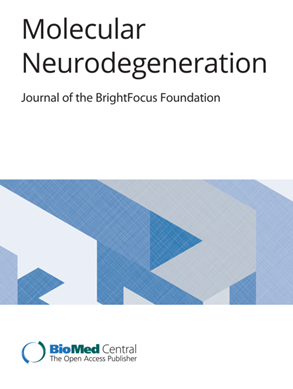单等位基因TYROBP缺失是阿尔茨海默病的一个新的危险因素
IF 17.5
1区 医学
Q1 NEUROSCIENCES
引用次数: 0
摘要
TYROBP和TREM2的双等位基因功能丧失变异导致常染色体隐性老年性痴呆伴骨囊肿,称为Nasu-Hakola病(NHD,或多囊性脂膜性骨质增生伴硬化性脑白质病,PLOSL)。其他一些TREM2变异会增加阿尔茨海默病(AD)和额颞叶痴呆的风险,而有害的TYROBP变异在全球范围内极为罕见,它们在神经退行性疾病中的作用尚不清楚。芬兰人的种群历史倾向于丰富有害的始祖突变,包括包含TYROBP外显子1-4的5.2 kb缺失,导致纯合携带者的NHD。在芬兰生物库研究FinnGen中,我们结合520,210名芬兰人的基因组和健康登记数据,使用了一个代理标记来识别单等位基因TYROBP缺失携带者。我们发现,与非携带者相比,单等位基因TYROBP缺失与阿尔茨海默病和痴呆症的风险增加和发病年龄提前相关。此外,我们提出了首例报道的单等位基因TYROBP缺失携带者与nhd型骨囊肿的病例。从机制上讲,单等位基因TYROBP缺失导致髓细胞中DAP12蛋白(由TYROBP编码)水平下降。通过对人类单核细胞来源的小胶质样细胞的转录组学和蛋白质组学分析,我们发现在脂多糖刺激下,与具有两个TYROBP功能拷贝的细胞相比,单等位基因TYROBP缺失导致炎症反应上调和未折叠蛋白反应下调。总的来说,我们的研究结果表明TYROBP缺失是AD的一个新的危险因素,并为治疗靶向提供了特定的途径。本文章由计算机程序翻译,如有差异,请以英文原文为准。
Monoallelic TYROBP deletion is a novel risk factor for Alzheimer’s disease
Biallelic loss-of-function variants in TYROBP and TREM2 cause autosomal recessive presenile dementia with bone cysts known as Nasu-Hakola disease (NHD, alternatively polycystic lipomembranous osteodysplasia with sclerosing leukoencephalopathy, PLOSL). Some other TREM2 variants contribute to the risk of Alzheimer’s disease (AD) and frontotemporal dementia, while deleterious TYROBP variants are globally extremely rare and their role in neurodegenerative diseases remains unclear. The population history of Finns has favored the enrichment of deleterious founder mutations, including a 5.2 kb deletion encompassing exons 1–4 of TYROBP and causing NHD in homozygous carriers. We used here a proxy marker to identify monoallelic TYROBP deletion carriers in the Finnish biobank study FinnGen combining genome and health registry data of 520,210 Finns. We show that monoallelic TYROBP deletion associates with an increased risk and earlier onset age of AD and dementia when compared to noncarriers. In addition, we present the first reported case of a monoallelic TYROBP deletion carrier with NHD-type bone cysts. Mechanistically, monoallelic TYROBP deletion leads to decreased levels of DAP12 protein (encoded by TYROBP) in myeloid cells. Using transcriptomic and proteomic analyses of human monocyte-derived microglia-like cells, we show that upon lipopolysaccharide stimulation monoallelic TYROBP deletion leads to the upregulation of the inflammatory response and downregulation of the unfolded protein response when compared to cells with two functional copies of TYROBP. Collectively, our findings indicate TYROBP deletion as a novel risk factor for AD and suggest specific pathways for therapeutic targeting.
求助全文
通过发布文献求助,成功后即可免费获取论文全文。
去求助
来源期刊

Molecular Neurodegeneration
医学-神经科学
CiteScore
23.00
自引率
4.60%
发文量
78
审稿时长
6-12 weeks
期刊介绍:
Molecular Neurodegeneration, an open-access, peer-reviewed journal, comprehensively covers neurodegeneration research at the molecular and cellular levels.
Neurodegenerative diseases, such as Alzheimer's, Parkinson's, Huntington's, and prion diseases, fall under its purview. These disorders, often linked to advanced aging and characterized by varying degrees of dementia, pose a significant public health concern with the growing aging population. Recent strides in understanding the molecular and cellular mechanisms of these neurodegenerative disorders offer valuable insights into their pathogenesis.
 求助内容:
求助内容: 应助结果提醒方式:
应助结果提醒方式:


